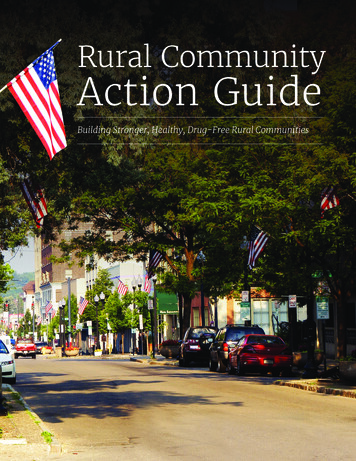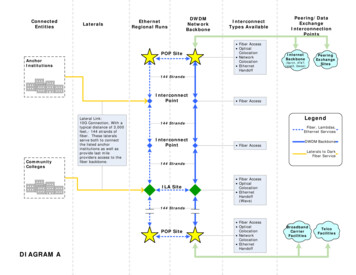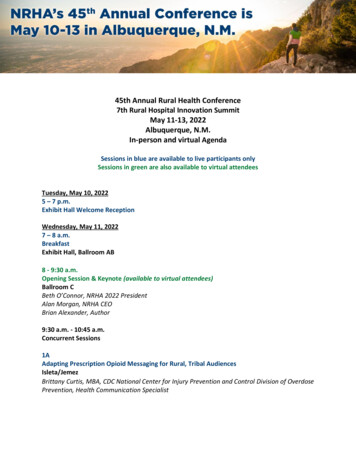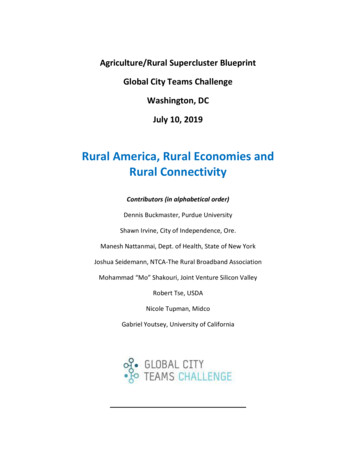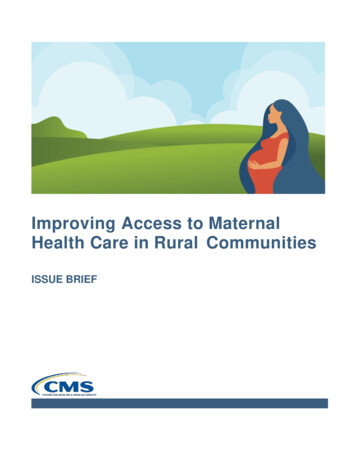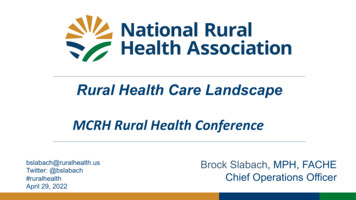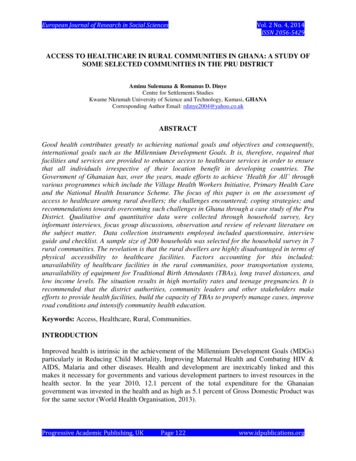
Transcription
European Journal of Research in Social SciencesVol. 2 No. 4, 2014ISSN 2056-5429ACCESS TO HEALTHCARE IN RURAL COMMUNITIES IN GHANA: A STUDY OFSOME SELECTED COMMUNITIES IN THE PRU DISTRICTAminu Sulemana & Romanus D. DinyeCentre for Settlements StudiesKwame Nkrumah University of Science and Technology, Kumasi, GHANACorresponding Author Email: rdinye2004@yahoo.co.ukABSTRACTGood health contributes greatly to achieving national goals and objectives and consequently,international goals such as the Millennium Development Goals. It is, therefore, required thatfacilities and services are provided to enhance access to healthcare services in order to ensurethat all individuals irrespective of their location benefit in developing countries. TheGovernment of Ghanaian has, over the years, made efforts to achieve ‘Health for All’ throughvarious programmes which include the Village Health Workers Initiative, Primary Health Careand the National Health Insurance Scheme. The focus of this paper is on the assessment ofaccess to healthcare among rural dwellers; the challenges encountered; coping strategies; andrecommendations towards overcoming such challenges in Ghana through a case study of the PruDistrict. Qualitative and quantitative data were collected through household survey, keyinformant interviews, focus group discussions, observation and review of relevant literature onthe subject matter. Data collection instruments employed included questionnaire, interviewguide and checklist. A sample size of 200 households was selected for the household survey in 7rural communities. The revelation is that the rural dwellers are highly disadvantaged in terms ofphysical accessibility to healthcare facilities. Factors accounting for this included:unavailability of healthcare facilities in the rural communities, poor transportation systems,unavailability of equipment for Traditional Birth Attendants (TBAs), long travel distances, andlow income levels. The situation results in high mortality rates and teenage pregnancies. It isrecommended that the district authorities, community leaders and other stakeholders makeefforts to provide health facilities, build the capacity of TBAs to properly manage cases, improveroad conditions and intensify community health education.Keywords: Access, Healthcare, Rural, Communities.INTRODUCTIONImproved health is intrinsic in the achievement of the Millennium Development Goals (MDGs)particularly in Reducing Child Mortality, Improving Maternal Health and Combating HIV &AIDS, Malaria and other diseases. Health and development are inextricably linked and thismakes it necessary for governments and various development partners to invest resources in thehealth sector. In the year 2010, 12.1 percent of the total expenditure for the Ghanaiangovernment was invested in the health and as high as 5.1 percent of Gross Domestic Product wasfor the same sector (World Health Organisation, 2013).Progressive Academic Publishing, UKPage 122www.idpublications.org
European Journal of Research in Social SciencesVol. 2 No. 4, 2014ISSN 2056-5429Globally, the rural population is almost 50 percent of the total human population as availabledata provides that by the middle of 2009, the number of people living in rural areas was 3.41billion and urban areas 3.42 billion (United Nations, 2009). The Ghanaian context presents asimilar case as 49.1 percent of the population lives in the rural areas (Ghana Statistical Service,2012). A recent United Nations report indicated that if the MDG4: Target 4.a (Reduce by twothirds, between 1990 and 2015, the under-five mortality rate) is to be met, efforts mustconcentrate on those countries and regions where child death rates are highest. Such places wereidentified as the developing regions and rural areas (United Nations, 2013). Also, access tohealth services is inadequate and poor in deprived and rural areas consequently, the poor sufferfrom the appalling cost of ill health from two perspectives: from the cost of accessing servicesand from productive days lost (Ministry of Health, 2007). Achieving a decent health statusamong the populace and realizing the MDGs requires that access to good quality healthcare isimproved significantly in the countryside however, this has been horrendous to manygovernments particularly, the developing world.Lu et al (2010) identified inadequate health facilities, long distances to health facilities, lack ofeffective and efficient transportation systems, inadequate health personnel and inability to affordthe cost of health services as major hurdles constraining rural people from accessing healthservices. In a study undertaken by Adam W., et al (2004), similar factors were identified ashinderingchild health among the poor especially rural dwellers and these consequently hadeffects on the gap in mortality rates between rural and urban areas. This is worse among ruraldwellers that live along water bodies that access health services from district capitals astransportation is a critical issue to accessing health services.As a matter of importance, the Ghanaian government has not lent deaf ears to the situation assome efforts have been made by the government to enhance access to quality health care amongrural dwellers. Unfortunately, efforts by the government to achieve a close-to-client servicedelivery which is mostly a step to reaching the rural populace have not achieved its objectivesover the years (Ministry of Health, 1979; 1998). Village Health Workers (VHW) were suggestedas the way forward to developing a reasonably priced health services to the rural poorand toenhance access since earlier efforts have not yielded the needed results though some successeswere made (Neumann et al. 1974;Lamptey et al. 1980, 1984 in Nyonator et al, 2005). This wassuccessful but when it was scaled up, it faced some challenges and hence, could not survive.Cole-King et al. (1979) identified some of the challenges to be organizational, resource, training,monitoring and supervisionproblems hence, the VHW system was abandoned in the 1980s.Regardless of the variousstrategies for achieving ‘Health for All’ in the 1980s, in 1990 more than70% of all Ghanaiansstill lived over 8 km from the nearest health care provider(Ministry ofHealth 1998) and rural infant mortality rates weredouble the corresponding urban rates.Improving access tohealth care delivery therefore remained a central goal of healthsector and tilldate, rural dwellers are constrained (Nyonator et al, 2005). Other policies and strategies such asthe Community-based Health Planning and Services (CHPS) was introduced in 1999 and theNational Health Insurance Scheme (NHIS) in 2004 to help achieve health for all irrespective ofthe economic and geographical conditions of individuals.In recent times, there have been little research to ascertain barriers to geographical access tohealthcare particularly, in rural areas. This paper assesses the state of healthcare access amongProgressive Academic Publishing, UKPage 123www.idpublications.org
European Journal of Research in Social SciencesVol. 2 No. 4, 2014ISSN 2056-5429rural dwellers, the challenges encountered and the coping strategies, and to recommend the wayforward to overcoming such challenges. The paper has analyzed the effects of poor access tohealthcare on maternal and child mortality and recommend ways to improving access tohealthcare in rural communities.MATERIALS AND METHODSThe Pru District has 10 health care facilities made up of one (1) mission hospital at the districtcapital (Yeji), three Health Centres, One Rural Clinic, three Maternity Homes and 2 other clinicsone of which is privately managed. This presents a major problem of inadequate healthinfrastructure in the area as a result, efforts have been made by the Assembly to identify and traina total of about 56 Traditional Birth Attendants to support. The district has a major healthchallenge and this is manifested in the quantitative and qualitative health needs as data showsthat as at 2009, the District had Four (4) Doctors, 68 Nurses, 2 Dispensing professionals, 8Laboratory Technicians, 5 Medical Record Technician and 6 Disease Control Officers. TheDoctor patient ratio for the District is therefore 1:30,854 as compared to the national ratio of 1:925. The Nurse patient ratio is however 1: 1,815 and poor for rural dwellers due to challenges inthe form of physical and economic accessibility.The existing number of facilities in the District clearly indicates that some communities have lowaccess to health care facilities. According to data from the 2003 Core Welfare IndicatorsQuestionnaire survey, about 32.3percent of households are within the reach to the nearest healthfacility as compared to the regional average of 53.85percent (Pru District Assembly, 2010). Thesituation is worse for rural dwellers as these facilities are somewhat distributed among the majorcentres such as Yeji, Zabrama, Abease, Prang, Parambo. In terms of distance from nearest healthfacility to localities, 92.7percent of the localities in the District have traditional healers, thus seektreatment from them whereas 2.8percent of the population have clinics within their locality,compared 0.7percent to hospitals(Pru District Assembly, 2010). Rural dwellers are thereforefaced with several healthcare problems and in some cases rely on traditional healers and otherunqualified personnel. Figure 1 presents the location of the district in the National context.Figure1 presents the location of the district in the national context.Progressive Academic Publishing, UKPage 124www.idpublications.org
European Journal of Research in Social SciencesVol. 2 No. 4, 2014ISSN 2056-5429Fig 1: Pru District in National ContextSource: Adapted from PruDisctrict Assembly, 2010Progressive Academic Publishing, UKPage 125www.idpublications.org
European Journal of Research in Social SciencesVol. 2 No. 4, 2014ISSN 2056-5429A preliminary survey was carried out through which relevant institutions such as the DistrictHealth Directorate (DHD), Non-Governmental Organizations, and other local authoritieswere identified and consulted for background information on health and health related issues.The research topic was discussed with the identified institutions and this was followed bypretesting the institutional questionnaires. The area was visited and a meeting held with thecommunity leaders such as the Assemblyman, unit committee members, youth leaders andsome traditional leaders.Seven (7) communities were selected for the survey. The household survey involved 200households who were selected randomly with the help of the Assemblymen, unit committeemembers and youth leaders. A Focus Group Discussion was held in all communities and keyinformants such as the chiefs, Assemblymen, unit committee members, teachers, and youthleaders were interviewed to help collect valid information.Information was also collected from the District Health Directorate precisely the PrimaryHealth Unit, Disease Control Office, Family Planning Unit, and some healthcare providerssuch as Bernice Clinic, St. Mathias Hospital and two TBAs. Data from the Key Informantsand Focus Group Discussions were collated on a sheet and the household survey in StatisticalPackage for Social Science (SPSS) for further analysis.RESULTS AND DISCUSSIONAvailability and Utilization of Health FacilitiesResults show health facilities were not available in all sampled communities however, someof the communities had Traditional Birth Attendants (TBAs). Access to healthcare istherefore a major challenge for the inhabitants of these communities. Over 70 percent ofrespondents however indicated that they have accessed at least one of the following healthfacilities: Health Centres, Clinics and hospitals located in the urban areas particularly thedistrict capital. As a result of the long distances (at least 20 kilometers) and the ineffectivetransport systems, accessing these health facilities is discouraging hence, one accesses thesefacilities when the health condition is severely bad and also in emergency situations. Thisresults in increased health cost as a result of high cost of transportation to the district capitaland in some cases, loss of lives. The survey revealed that during emergencies, the only meansof transportation available to inhabitants is to hire the services of a tricycle operator andsometimes a boat which are relatively expensive (about GH 15.00 US 4.95) for the ruraldwellers with an average annual income of GH 3,655.00 US 1,205.28). The situation iseven worse due to the seasonal nature of the income earned by the rural dwellers.Family Planning ServicesAlthough family planning to a large extent helps in reducing the burden of parents (byreducing family/household sizes), prevent unwanted pregnancies and reduce infant andmaternal mortality, some respondents (45 percent) do not see it as being relevant. Seventythree(73)percent of respondents indicated that they have practiced some form of familyplanning mainly; condom use, injectable (Depo Provera) and implants (Norplant) and IntraUterine Device (IUD).Although the patronage was high, it was sad to find that only 21 percent of family planningusers showed a positive attitude towards the practice as the majority (79 percent) wereinconsistent in terms of usage and did not follow the routine visits as prescribed by theservice providers. Such respondents were mainly from communities such as Korancha,Progressive Academic Publishing, UKPage 126www.idpublications.org
European Journal of Research in Social SciencesVol. 2 No. 4, 2014ISSN 2056-5429Pajero-kura, Asemka and Kajaiand were mainly individuals who used depoprovera(injectable). The reasons assigned to such inconsistencies were basically long distances,unavailability of readily available transport means which invariably results in high transportcosts hence discouraging clients from accessing such services from the district capital. Afemale respondent stated that “I do not see why I should travel over 30 kilometers and payfor a transport fare of about GH 15 just to access family planning service. My husband willnot even give me the money”.During an interview session with the staff of the most patronized health facilities; St. MathiasHospital and Bernice Clinic, it was revealed that family planning clients from the rural areasrarely comply with the required dates of visit and they come on market days sometimes 3 to 5days late and in rare cases, over a week. Some have also attributed it to lack of education andhence, cannot read the inscriptions and instructions provided. This to some extent is valid asthe study found that less than 30 percent of family planning users have received some level offormal education with the majority (over 75percent) having no form of education particularlythe females. This has resulted in unwanted pregnancies and contributed to the high rate ofteenage pregnancy in the district as 14.1 percent of registered antenatal cases were teenagers(Pru District Assembly, 2010) and some do not register for antenatal services but thecommunity gets to know when such girls drop out of school and during birthing. Thesituation also has effects on household size as the average household size was as high as 8.1persons and some respondents attributed the high household size to lack of proper parentalcare, poor attitude towards family planning and the need for larger family sizes for fishingactivities.In effect, access to family planning services is poor due to the lack of health facilities, longtravel distances, low income levels among inhabitants and the low level of education andknowledge among inhabitants. Interventions will therefore be required in provision of therequired facilities and intensive family planning education to influence the attitude andbehavioral pattern of inhabitants.Antenatal and Post natal ServicesAll (100 percent of respondents) indicated their awareness of the benefits of regular antenataland postnatal care visits to the health of the child and the mother. In all, only 12 percent offemale respondents indicated that they do not visit any health facility for such servicesmaking the picture an impressive one. However,for those who accessed such services, only 8percent visited the facilities regularly. Interacting with two sonographers in the two majorhealth facilities in the district capital, it was revealed that pregnant women are expected tovisit any health facility at least 3 times for gynecological examinations before delivery.However, clients often come once with a small proportion (less than 20 percent) visitingtwice.The sonographers indicated that clients do well to come once because their focus is to knowthe sex of the unborn child after which they ignore the other germane medical issues such asthe positioning of the fetus in the right state within the uterus. Consequently, many (about 40percent) of them faced complications during childbirth or delivery as some fetus may bepositioned wrongly within the uterus. Other effects mentioned included high medical cost ascomplicated deliveries require surgical operations; which is not available in the rural areashence, calling for transport cost and operational cost. In some cases, complicated deliverieshave resulted in the loss of the mother or the child.Progressive Academic Publishing, UKPage 127www.idpublications.org
European Journal of Research in Social SciencesVol. 2 No. 4, 2014ISSN 2056-5429Also, for the rural dwellers, their major point of delivery was the services of the TraditionalBirth Attendants who in this context lack a facility for operations or activities. The situationis exacerbated by the lack of the required materials and equipment such as Apron, goggle,face mask and gown, sterile gloves, sterilized scissorsfor aiding delivery and this exposes theTBA, the mother as well as the child to health risks (See Box 1 for the checklist). Due to thelack of a health facility for the TBAs, services are provided in the homes of clients. The twoTBAs interviewed indicated that they travel to surrounding communities to providehealthcare services to clients during emergency circumstances. TBAs do not provide servicesto the following group of clients: Individuals are who giving birth for the first time in their lives. Such clients are likelyto face difficulties as a first time experience in delivery. They therefore require theservices of a trained midwife and in a facility with the required equipment.Individuals who have giving birth for more than 5 times. These clients have weakuterus and may end up requiring surgical operations for help them deliver.Individuals who face complications during delivery.Such clients therefore require the services of a higher level health facility however, these arelacking in the rural areas making access a difficult issue. When pregnant women are referredto health facilities in the district capital, they face a major challenge with transportation asthere are no readily available means of transport. As a result, the TBA helps in calling someindividuals who own tricycles in the district capital to come to their aid. This is worsened bythe poor communication services in the rural areas as respondents indicated that there is onlyone point where they are able to make phone calls and even with that, the place is notreliable. In a Focus Group Discussion in Kajai, the members indicated that about 4 womenlost their children during such emergencies in the year 2014 (in a period of 5 months).Access to antenatal and postnatal services are generally poor in the sampled communities as aresult of unavailability of health facilities, human resource and equipment, poorcommunication services and the lack of effective and efficient transport systems. This resultsin increasing infant and maternal mortality and this makes the realization of the MDG 3 adream than a reality.Box 1: Checklist of Child Birth Equipment Clean water, soap and hand towel.Apron, goggle, face mask and gown.Sterile gloves.New razor blade or sterilised scissors.Sterile or very clean new string to tie the cord.New razor blade or sterilised scissors.Antiseptic solution for cleaning the mother’s perineum and genital area.10 IU (international units) of the injectable drug called oxytocin, or 600 µg(microgram) tablets of misoprostol.Tetracycline eye ointmentThree buckets or small bowls each with 0.5 percent chlorine solution, or soapsolution and clean water.Plastic bowl to receive the placenta.Two sterile clamp forceps.Sterile gauze, cotton swab and sanitary pad for the mother.Two dry, clean baby towels and two drapes.Progressive Academic Publishing, UKPage 128www.idpublications.org
European Journal of Research in Social Sciences Vol. 2 No. 4, 2014ISSN 2056-5429Blood pressure cuff and stethoscope.Antiseptic solution for cleaning the mother’s perineum and genital area.Three buckets or small bowls each with 0.5 percent chlorine solution, or soapsolution and clean water.Plastic bowl to receive the placenta.Researchers’ Field Survey, 2014Common DiseasesFrom the study, the major diseases identified included endemic diseases such as Malaria andchronic diseases such as diabetes and hypertension. About 63 percent of respondentsindicated that at least a member of their households were attacked by malaria at the time ofthe survey. For hypertension and diabetes, 17 percent and 6 percent of respondents stated thatsome of their household members were attacked by the diseases. It must be emphasized thatsome respondents highlighted that they had a perception that some individuals havecontracted the diseases but have not been diagnosed because they have not visited any healthfacility for examinations. By implication, a larger number might be suffering from suchdiseases and therefore require regular visits to health facilities for monitoring however, suchindividuals do not access any healthcare services due to lack of health facilities in their areaand the long distances required to cover in other to access such services.Snake bite was identified as one of the major causes of mortality in the sampled communities.Some key informants such as the Assemblyman, unit committee leaders and the chiefsindicated that about 10 people had died by from January to June, 2014 as a result of snakebites. During the focus group discussion, about 74 percent of participants pointed out thatsnake bites are among the major health issues in their area as many people die due to lack ofhealth facility to respond to such emergencies, poor transport systems and the inability ofindividuals to afford the healthcare cost. Although about 63 percent of the population wereregistered with insurance, access to healthcare has been poor and respondents indicated thatthey will not register again. Their reason was that due the unavailability of health facilities,registered beneficiaries of the National Health Insurance Scheme (NHIS) do not access healthfacilities except in emergency situations which in their context is mainly snake bites which isnot covered by the NHIS.Attitude towards Expanded Programme on Immunization (EPI)EPI is employed to work against the six diseases namely Tuberculosis, Poliomyelitis,Diphtheria, Whooping cough, Neonatal Tetanus and Measles. 86 percent reported that theEPI health workers have visited their villages and have vaccinated their children against thesix deadly diseases. However, parents do not take their children to the health facilities forother primary healthcare services due to long distances and long waiting time as there is somuch pressure on the health facility in the district capital. Only 13 percent indicated that theyvisit the Primary Healthcare Unit (PHC) regularly. This might have effects on the growth oftheir children and sometimes results in deformity and forfeiture of children.Progressive Academic Publishing, UKPage 129www.idpublications.org
European Journal of Research in Social SciencesVol. 2 No. 4, 2014ISSN 2056-5429Coping Strategies: Saving for Delivery/BirthAccess to healthcare is very important especially for birth. In the midst of the seriouschallenges of accessing healthcare, the rural people save some money for birthing as a copingstrategy. About 70 percent of households indicate that their way of coping with the situationis to keep some money with friends and relatives when their wives get pregnant to ensure thatthey get money for transport and other healthcare expenditure required.On the average, an amount of (GH 400.00 US 131.90)is saved. Although this approach hasbeen helpful, it had a major weaknesses; unreliability of the individuals who keep the moneyas some of them spend the money and when it was required, such individuals could notprovide. As a result, inhabitants prefer to save with financial institutions however, these arenot available in the rural areas and the problem would exist during emergencies. Staying with Relatives in the District CapitalAnother major strategy adopted by these rural dwellers is to take their pregnant wives to thedistrict capital to stay with their relatives. This is usually done when the pregnancy is over 6months old. This gives them the opportunity to access any health facility as the physicalaccessibility has been improved due to proximity to the health facilities. The weakness withthis strategy is that for those (some 57 percent of respondents) who do not have relatives inthe district capital, they cannot employ such a strategy. However, some members of a FGDindicated that though they do not have relatives in the district capital, they employed thestrategy because they had rented rooms in the district capital. It must also be noted thatrenting is an extra cost to the expenditure of the households and not all households couldafford such services. The average annual rent for a single room was(GH 240.00 US 79.14)in which 73 percent of respondents were not willing to pay due tolow income levels (Researchers’ Field Survey, 2014).RECOMMENDATIONS Provide health facilityIn the short to medium term, the District Assembly, community leaders and other NonGovernmental Organizations should provide the communities with a health post, CHPSCompound or community clinic which is expected to be located in the Kajai community toserve the surrounding communities as it is the central community. An ambulance should beprovided to these communities to help carry clients to the hospitals and other higher levelhealth facilities in the district capital when the need arises. Also, motorcycles retrofitted withsidecars to take residents to clinics in the district capital. Capacity BuildingThe district authorities and other stakeholders should also build the capacity of the TBAsthrough constant training and the supply of required equipment to help them carry out theirroles as expected. Intensify Community Health EducationAlso, the District Health Directorate should ensure that health education is intensified in theserural areas to help change the perceptions and negative attitudes of these people towardsProgressive Academic Publishing, UKPage 130www.idpublications.org
European Journal of Research in Social SciencesVol. 2 No. 4, 2014ISSN 2056-5429family planning and the Expanded Programme on Immunization. Education can be done atleast once in every month. Improve road ConditionsEfforts should be made to improve the road conditions especially the Abease-Zabrama roadas this is the major access routefor the surrounding communities. Although some efforts havebeen made in this direction, some pot holes exist and community efforts will be required tocompletely resolve such a problem. Communication ServicesIn the long term, the District Authorities and other stakeholders are expected to collaboratewith the private sector (Network Service Providers such as Vodafone, MTN, among others)to provide better network services to such communities to improve the communicationservices.CONCLUSIONAccess to health facilities and services is prudent to ensuring high living standards among thepopulation hence, irrespective of one’s geographical and socio-economic circumstances,access to health must be a basic service. However, the situation has been poor in theGhanaian context, particularly for the rural dwellers.The study found that the factors inhibiting access to health facilities and services by the ruralpopulace are multidimensional and somewhat related ranging from physical accessibilityproblems, low income levels, low technological issues, high illiteracy, among other factors.The effects of the situation are numerous including complications during birthing, increasedinfant and maternal mortality, teenage pregnancies and high rate of social vices. If thesituation persists, the realization of the MDGs particularly MDGs 1, 4, 5 and 6 will be farfrom reach hence requiring urgent intervention by all stakeholders to attack the situationholistically.REFERENCESAdam W., et al (2004). Child Health: Reaching the Poor.America Journal of PublicHealth.2004 May; 94(5): 726–736.GSS (2012).2010 Population and Housing Census.Ghana Statistical Service. Accra, Ghana.Lu N., Samuels M. E., Kletke P. R., &Whitler E. T. (2010).Rural-Urban Differences inHealth Insurance Coverage and Patterns among Working-Age Adults in Kentucky.Journal of Rural Health, 26: 129 – 138.Ministry of Health of the Republic of Ghana.(1979).Primary Health CareStrategy.Ministry ofHealth. Accra, Ghana.Ministry of Health of the Republic of Ghana.(1998).A profile of healthinequities inGhana.Ministry of Health. Accra, Ghana.Nyonator, F.K., et al (2005). The Ghana Community-based Health Planning and ServicesInitiative for scaling up service delivery innovation. Health Policy and Planning; 20(1): 25–34. Oxford University Press.Pru District Assembly (2010).Medium Term Development Plan (2010-2013) under GhanaShare Growth and Development Agenda, District Planning Coordinating Unit.Yeji,Ghana.United Nations (2009).Monitor
healthcare on maternal and child mortality and recommend ways to improving access to healthcare in rural communities. MATERIALS AND METHODS The Pru District has 10 health care facilities made up of one (1) mission hospital at the district capital (Yeji), three Health Centres, One Rural Clinic, three Maternity Homes and 2 other clinics
